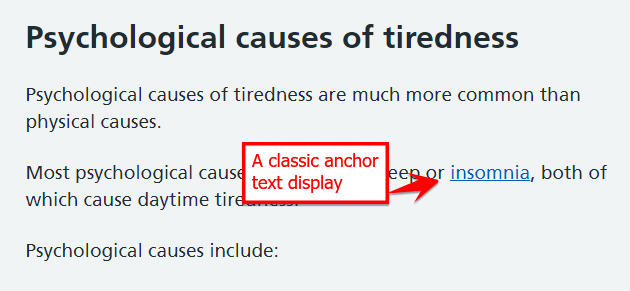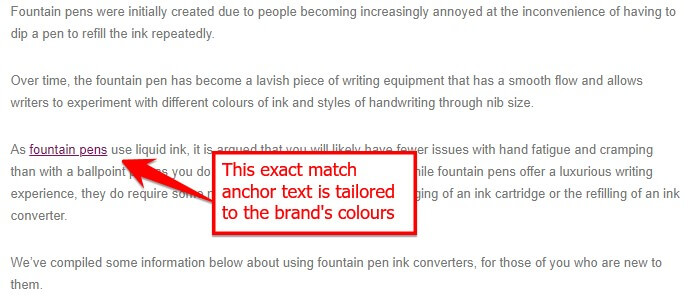What is anchor text?
Anchor text is clickable text that links to a webpage. It entices visitors to click through with an indication of what they will find when they do.
Also known as ‘link labels’ or ‘link titles’, search engines use anchor text as one of the signals for determining a page’s subject matter.
Search engines then rank the page using this knowledge, alongside a range of other factors.
Often, anchor text will be displayed in blue and underlined, although this can be changed within the html of a site and so you’ll find variations of it out in the wild.
The below example is taken from the NHS website:

This example is taken from The Pen Company’s website and shows how the display of anchor text can vary:

Anchor text types
There are a wide variety of anchor text types, and it is essential to use an array across your site to please both search engines and site users.
Below I outline each anchor text type, sharing a definition of each and examples of them in use.
Exact-match anchor text
Often referred to as the king of all anchor text, exact-match anchor text uses the page’s primary target keyword.
For an example of exact-match anchor text in a retail context, the anchor text ‘leather brogues’ would link the user to an eCommerce page featuring a selection of leather brogues.
Exact-match anchor text can have a significant impact upon your rankings — either helping you to rank or ruining your chances if you overuse it.
While the occasional use of exact match anchor text is excellent, overuse triggers a spam filter within Google and has done since the Penguin algorithm update of 2012. Before this time, manipulative link building practices were common.
Partial-match anchor text
A twist on exact-match, partial-match anchor text uses the primary keyword but utilises additional words around it.
For example, if my primary keyword was ‘fountain pen’, the partial match anchor text might be:
- Read this fountain pen guide
- Learn more about the fountain pen
- This fountain pen was designed by Lamy
Naked link anchor text
Naked link anchor text always features a raw URL. For example:
- https://salt.agency/
- thepencompany.com
More often than not, naked link anchor text is found on a contact page.
Generic anchor text
Generic anchor text is not associated with the primary keyword and is often used as a call-to-action (CTA).
For example:
- Click here
- This article
- This website
Generic anchor text within a sentence (in bold):
- To learn more about recycling, click here.
- This article explains the process.
- This website is dedicated to the music of Queen.
The CTA is the crucial aspect of this type of anchor text — a user is far more likely to click on anchor text that says “Click here” than anchor text that says “red balloons”. Therefore, this anchor text type is multi-functional and highly useful for the user.
Branded anchor text
Branded anchor text is any anchor text that mentions your brand name. For example:
- SALT.agency
- Ahrefs
Branded anchor in a sentence:
- SALT.agency is a bespoke technical SEO agency.
- I use Ahrefs to explore backlink profiles.
- My preferred search engine is Google.
Image anchor
The “alt” tag for an image is read as anchor text by Google. If this is left blank, then the anchor text will read as “noText”.
Which anchor text is best?
So, you might be looking at all of the above types wondering which you should be using on your website. After all, there are many to choose from.
In short, no anchor text is ‘better’ than another — each suit different sentences or copy types. Use anchor text organically, employing a mixture of types in each piece of copy as you naturally would, to create rich and diverse pieces of content.
What is the point of anchor text?
Google uses the anchor text on other sites to understand what your site is about.
For example, if I were to link to your site in this article and the anchor text was ‘Greek holidays’, and then other websites did the same, Google would understand that the likelihood of your website having something to do with Greek holidays would be high.
What does Google do about this? It decides the page might need to rank for ‘Greek holidays’.
Of course, there are other factors that search engines consider too when ranking pages; this is just one of many.
While backlinks with relevant anchor text are essential, so is quality and highly relevant landing page copy, for example.
Final thoughts
In summary, anchor text is a useful tool when used organically. There are many anchor text types, and it is best to diversify by using a wide range of them within your site’s pages, to satisfy both the reader and Google.